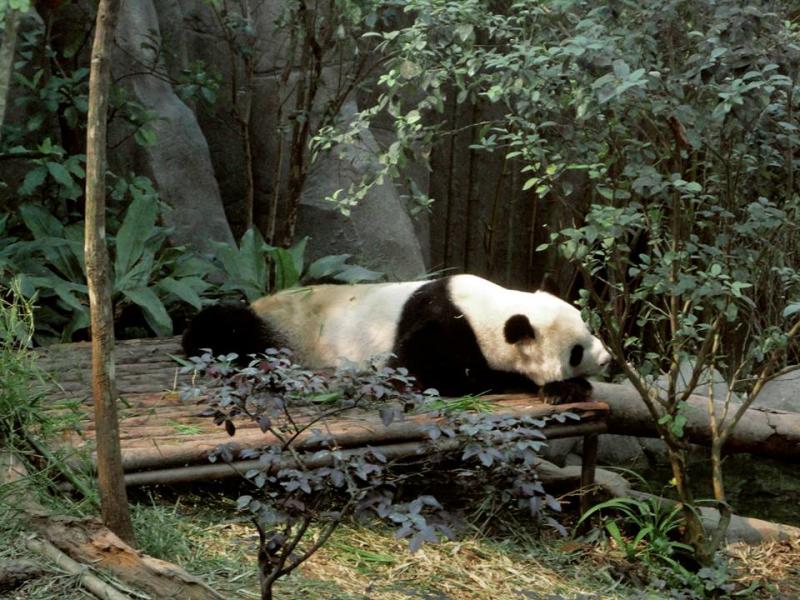1,600.
That’s the estimated number of giant pandas which still exist in the wild. About 300 more live in zoos and breeding centers around the world.
In a diplomacy between China and Singapore, two giant pandas (Kai Kai and Jia Jia) are sent for 10-year holiday to River Safari Singapore, beginning from September 2012. Everyone loves Kai Kai and Jia Jia, and they are probably more famous than any local celebrities in Singapore.
Mimicking Giant Panda’s Habitat
Giant pandas reside high in the mountains of Western China, deep inside bamboo forests on the upper region of Yangtze River.
A giant panda’s daily menu consists entirely of bamboos. Bamboo leaves, bamboo stems, bamboo shoots… however, as bamboo contains very little nutritional value, they must eat about 12-38 kg per day in order to fulfill their energy needs.
Due to the low-energy diet, giant pandas avoid stressful situations most of their time.

No wonder Kai Kai was so sleepy when we visited him
(Jia Jia was nowhere to be found, but probably sleeping in her cave too)
They spend about 10 hours of their day sleeping, and 14 hours eating. They can be active both in daytime and nighttime, so you have to bank on your luck if you want to catch Kai Kai and Jia Jia in action.
Book a trip to meet Kai Kai and Jia Jia in River Safari here.

A newborn giant panda is about the size of a stick of butter. They are fully dependent on their mothers for about 8-9 months. They live on their own after 18 months.
Red Panda
We also saw two red pandas roaming inside the Giant Panda Forest.
Red pandas share traits with the giant pandas as they predominantly feed on bamboos and have extra “thumbs” to hold their food. They are native to the eastern Himalayas and southwestern China. These cuties are about the size of a domestic cat.

Similar to their black-and-white cousins, red pandas are also endangered. Their populations are dwindling very quickly due to habitat loss. Moreover, red pandas are often caught in animals traps meant for wild pigs and deers.
A Shrinking Habitat: How to Save Pandas from Extinction
Giant pandas were once widespread throughout China, as well as neighboring Myanmar and Vietnam. Due to expanding human development, the species are quickly losing their homes and are now confined to their last few remaining isolated forests.
To ease pressure on our natural resources, here are a few easy changes that we can implement from now in our daily lives:
1. Buy products made from sustainable woods with Forest Stewardship Council label
2. Minimize usage of disposable bags by buying in bulk or bringing your own bag
3. Volunteer or donate to organisations such as WWF that are making conservation efforts to endangered animals
4. Spread the words out, share stories about giant panda in social media, blogs, etc.
For other things that we can do, click here for more.
You can read more about River Safari Singapore by continuing to Wild Amazonia or going back to 7 Rivers of the World.
Book a trip to River Safari here.
Reblogged this on Random Repeat.
LikeLike
Hello, after reading this amazing piece of writing i am also cheerful to
share my knowledge here with colleagues.
LikeLike